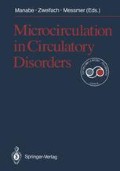Abstract
An understanding of the disturbance of microvascular regulation requires first that we understand the normal state. Our current understanding of normal regulation has developed slowly over many years. The earliest view of the regulation of the peripheral circulation was that blood flow to the tissues was determined essentially by sympathetic constriction of arterial vessels and by arterial perfusion pressure. To the extent that the special needs of organs for increased blood flow were recognized (such as skeletal muscle in exercise), it was thought that neurally mediated local vasodilation was responsible. Shunting of flow among organs according to local needs was also hypothesized. For example, the vasoconstriction of skin blood vessels observed during mental activity was thought to increase total peripheral resistance by activation of the sympathetic nervous system, increasing arterial pressure, and, thereby, forcing more blood through the brain [1]. A few workers such as Roy and Brown [2] did suggest that locally produced metabolities such as carbon dioxide and hydrogen ions may cause vasodilation in special circumstances such as exercise and reactive hyperemia. But there was an overriding emphasis on the central regulation of all aspects of peripheral circulatory function.
Access this chapter
Tax calculation will be finalised at checkout
Purchases are for personal use only
Preview
Unable to display preview. Download preview PDF.
References
Howell WH (1918) A Textbook of physiology. Saunders, Philadelphia, p 634
Roy CS, Brown GJ (1880) The blood pressure and in the variations in the arterioles, capillaries and smaller veins. J Physiol (Lond) 2: 323–359
Berne RM (1964) Regulation of coronary blood flow. Physiol Rev 44: 1–29
Johnson PC (1964) Review of previous studies and current theories of autoregulation. Circ Res 15 (Suppl 1): 2–9
Folkow B (1955) Nervous control of the blood vessels. Physiol Rev 35: 629–663
Folkow B (1952) A study of the factors influencing the tone of denervated blood vessels perfused at various pressures. Acta Physiol Scand 27: 99–117
Lundgren O (1978) Alimentary canal. In: Johnson PC (ed) Peripheral circulation. Wiley, New York
Watkinson WP, Foley DH, Rubio R, Berne RM (1979) Myocardial adenosine formation with increased cardiac performance in the dog. Am J Physiol 236 (Heart Circ Physiol 5): H13–H21
Granger HJ, Shepherd AP (1973) Intrinsic microvascular control of tissue oxygen delivery. Microvasc Res 5: 49–72
Sullivan SM, Johnson P (1981) Effect of oxygen on blood flow autoregulation in cat sartorius muscle. Am J Physiol 241 (10): H807–H815
Jackson WF, Duling BR (1983) The oxygen sensitivity of hamster cheek pouch arterioles: In vitro and in situ studies. Circ Res 53: 515–525
Duling BR, Berne RM (1970) Longitudinal gradients in periarteriolar oxygen tension. Circ Res 27: 669–678
Johnson PC, Intaglietta M (1976) Contributions of pressure and flow sensitivity to autoregulation in mesenteric arterioles. Am J Physiol 231: 1686–1698
Boegehold M, Johnson PC (1988) Periarteriolar and tissue PO2 during sympathetic escape in skeletal muscle. Am J Physiol 254: H929–H936
Harder DR (1987) Pressure-induced myogenic activation of cat cerebral arteries is dependent on intact endothelium. Circ Res 60: 102–107
Eriksson E, Lisander B (1972) Low flow states in microvessels of skeletal muscle in cat. Acta Physiol Scand 6: 202–210
Lundvall J, Gustafsson D (1982) Impairment during marked hypotension of the plasma volume control in hemorrhage. Acta Physiol Scand 114: 371–378
Enevoldsen EM, Jensen FT (1977) “False” autoregulation of cerebral blood flow in patients with severe head injury. Acta Neurol Scand (Suppl) 64: 514–515
Johnson P (1980) The myogenic response. In: Bohr DF, Somlyo Ap, Sparks HV Jr (eds) Cardiovascular system. Handbook of Physiology, vol 2, chap 15. American Physiological Society, Bethesda, pp 409–442
Author information
Authors and Affiliations
Editor information
Editors and Affiliations
Rights and permissions
Copyright information
© 1988 Springer-Verlag Tokyo
About this chapter
Cite this chapter
Johnson, P.C. (1988). Microvascular Regulation: Normal Function and Disturbance in Disease. In: Manabe, H., Zweifach, B.W., Messmer, K. (eds) Microcirculation in Circulatory Disorders. Springer, Tokyo. https://doi.org/10.1007/978-4-431-68078-9_3
Download citation
DOI: https://doi.org/10.1007/978-4-431-68078-9_3
Publisher Name: Springer, Tokyo
Print ISBN: 978-4-431-68080-2
Online ISBN: 978-4-431-68078-9
eBook Packages: Springer Book Archive

